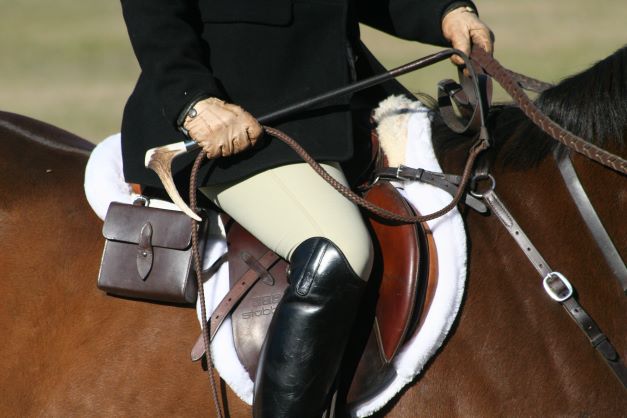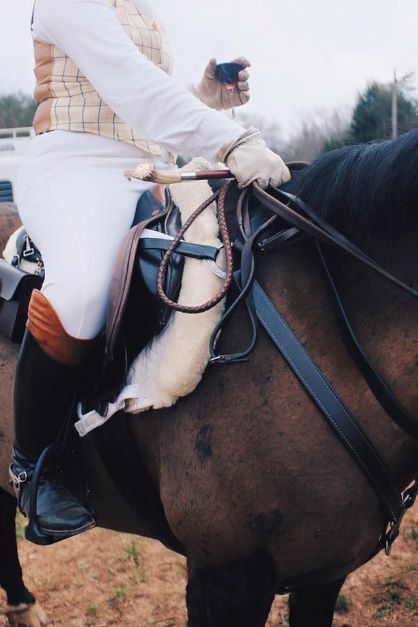 Photo by Gretchen Pelham.
Photo by Gretchen Pelham.
Everyone has their tricks and quirks to prepare for the day’s hunt. I have learned several tricks or hacks over the years that prevent problems or make things easier. Below are twenty tips that might also be helpful to you.
 Hunt buttons. Photo by Gretchen PelhamOne – Sewing on Buttons. Hunt buttons can be expensive, so the investment should be protected. Sew on your awarded buttons with either fishing line, carpet thread, or dental floss. When you travel, always take a packet of plain dental floss with your hotel sewing kit in case a button gets loose while away from home. Bonus Tip – put a flat, plain button on the underside of the coat (out of sight, next to your vest) as you sew on the hunt button. The backside button will add extra support.
Hunt buttons. Photo by Gretchen PelhamOne – Sewing on Buttons. Hunt buttons can be expensive, so the investment should be protected. Sew on your awarded buttons with either fishing line, carpet thread, or dental floss. When you travel, always take a packet of plain dental floss with your hotel sewing kit in case a button gets loose while away from home. Bonus Tip – put a flat, plain button on the underside of the coat (out of sight, next to your vest) as you sew on the hunt button. The backside button will add extra support.
Two – Waterproofing Fabric. Nothing is more miserable than getting soaked with hours still to go on the hunt. If you know ahead of time that rain is imminent, spray your hunt coat (especially the shoulders) and the top of the thighs on your breeches with a waterproofing spray. The only issue with this hack is that it can’t be done just before you put on these clothes – you must allow the spray to dry otherwise it will not be waterproof. The night before is the best time to spray. There are several waterproofing sprays for tents, canvases, marine sails, etc to choose from. I don’t recommend fabric sprays for furniture, as they are not made for a downpour.
Three – Windbreaking Layer. The wind seems to be especially vicious out West, and few hunt coats can outmatch the wind in a duel. Especially if it’s a Junior with zero body fat wearing the hunt coat. Putting a simple windbreaker as a layer between the hunt coat and the vest is very effective. Windbreakers are usually thin enough that they will fit invisibly under a hunt coat without too much added bulk, even with a hood. Any noise created by the windbreaker is worth not getting chilled to the bone from the crazy wind.
Four – Long Sleeve Reserve. When temperatures get high, just the thought of wearing long sleeves under a hunt coat can make one miserable. So many riders opt for short sleeves. The risk taken is what to do when the Masters waive coats. The look of short sleeves, or worse – sleeveless – with a vest is not attractive. The solution is to keep a long sleeve hunt shirt in your rig that you can quickly change into when coats are left at the meet. Bonus Tip – always bring your vest with you to the meet, even if you plan to ride without it under your coat. Just in case coats are waived. As the only thing worse than short sleeves showing is a stock tie without a vest to cover the tails.
Five – Change of Clothes. In my first year of hunting, I saw a lady get dumped into a very cold river. She was soaked to the bone, but when the hunt came back to the meet she had changed into a completely new set of dry clothes. If you have a duplicate set of hunting clothes to keep in your rig all season, then you are set. If not, then regular clothes will be a godsend, as the likelihood of you returning to the hunt field after a dunking is probably slim. Just remember to keep in your rig spare underwear and socks to go with your “In Case of Dunking” kit.
Six – Work Gloves. This is one of my quirks; I hate riding gloves, especially the Velcro at the wrists. Instead, at the hardware store, I buy leather work or gardening gloves. They are cheaper than riding gloves, and in my opinion, last longer. I usually buy several pairs once I find a stash in my size (small) and color (cream or tan). Some of the ranch stores out West carry a whole bonanza of leather gloves in goat, deer, and elk skin. Bonus Tip – if your riding gloves are black, then keep either string gloves or a pair of tan gloves for those rainy days. If the black gloves get wet, the black dye will most assuredly leach into your skin and dye your hands purple for days.
Seven – Easing Stock Pinning. The best stock tie fabric is easily pierced by the dullest stock pin. However, your favorite stock tie may be weaved too tight for easy pinning of multiple layers. If you’ve ever debated using a carpenter’s clamp in desperation, try this hack instead. Run the point of your open stock pin through your hair. The oil from your hair may help the pin to pierce fabric easier. Or maybe you just need to sharpen the point of your pin. Bonus Tip – after removing your stock tie, always attach your stock pin through your vest’s buttonhole so it never goes missing.
Eight – Securing Stock Ties. A flapping stock tie is the height of untidiness. During a hunt, no one should see the tails or ends of your stock tie. To secure your tie and avoid the wrath of your Master or Etiquette Queen, secure each end of your tie to your shirt. After the knot is tied and the stock pin placed, take a safety pin to each corner of the tie to your shirt – four pins total. Bonus Tip – Keep a tin full of extra pins in your rig, as they magically disappear when most needed. And to give away to those in need.
Nine – Hair Net Help. There are hair nets, and there are hair nets strong enough to survive a hunt without risking the wrath of the Etiquette Queen (remember that only Juniors should have visible hair braids). Trees love to reach in and rip holes in the traditional, more flimsy hair nets. And to get a whole ponytail inside a traditional hair net without any leaks is a skill set few possess. The more expensive hair net that is made like a tube is worth the extra money. Long or short hair, these tube nets make it easier to tame those flowing tresses that forever wish to escape confinement. Always buy two at a time to keep an extra in your rig. If you have hair long enough for a ponytail, resist the urge to do so. Instead, keep your hair loose and pull on the tube net like it’s a neck gaiter. Pulling it completely under all of your hair. Then simply pull up the top band like a sock until all your hair is inside and adjust the bottom band to cover the tops of your ears and the hairline on your forehead. Keep all that pilled net and hair on top of your head, then put your helmet on over it. The bulk will not be noticeable unless you have hair like a Gypsy Vanner. If that’s the case, well… good luck with your Etiquette Queen. Bonus Tip – for extra protection from hair leakage, use a thin hair band can be added, either on top or under the hair net, or add barrettes to the hairline to secure the net to your hair.
 Neck Strap, work gloves, long sleeve shirt, and an extra martingale snap by the sandwich case. Photo by Laura Pierpoint.
Neck Strap, work gloves, long sleeve shirt, and an extra martingale snap by the sandwich case. Photo by Laura Pierpoint.
Ten – Packing Extras. It never fails that those flimsy martingale snaps will pop after a fantastic run with time left still to go on the hunt. And most forward-placed D-rings on saddles are also not strong enough to withstand a hard pull up a steep hill with a fitted breastplate. It’s worth keeping on your saddle extra snaps and the D-rings that attach to your stirrup bars. Along the same lines, keeping a short braid of parachute cord in your pocket is helpful if a major leather piece fails on your tack while in the hunt field. It’s as useful as duct tape.
Eleven – Tacking Up. If your trailer allows for enough space, you can keep your horse in your trailer while you do final adjustments to your tack. Bridling inside the trailer, before you unload, can help if your horse loves to do giraffe impressions. Bonus Tip: Always mount up BEFORE the hounds are unboxed from their trailer to give your horse a chance to mentally warm up.
Twelve – Stashing Tools. Keeping a small, folding hoof pick or a compact multi-tool in your sandwich case or coat pocket can be of immense help when miles from your rig. The uses are too many to list.
Thirteen – Using Neck Straps. There are many uses for neck straps – as a jumping aid, an emergency aid when forced dismounts are imminent, and an aid when standing in the tack during back-crushing monster trots that are too big to post. You can even use a well-placed strap as a braking aid; not to mention it’s a great replacement for a broken stirrup leather. Fit the neck strap, either custom-made or a repurposed stirrup leather, to sit right where the neck and the shoulders meet. It should only be a few inches from the top of the breastplate. Secure it to the breastplate with either shoelaces (color matched to the horse), or leather ties (from a saddler or laces made for baseball mitts). If you don’t secure the neck strap it can slip down around the horse’s ears when he drops his head. Straps made from synthetic stirrup leathers are easier to clean than real leather. For a tidy look, secure the end past the buckle with leather laces. Bonus Tip – If you hate to braid, and your horse has a nice crest to his neck, then feel free to roach or hog the mane off. Many people are afraid to lose the mane as they are used to grabbing the mane over jumps. Instead, grab the neck strap and save yourself time from braiding or pulling a mane.
Fourteen – De-dusting the Horse. Not every foxhunter has access to hot water wash racks during hunt season. And living out in the desert, the ever-present dust just laughs at the futility of bathing a horse before a hunt. As soon as you load your horse and drive down the miles and miles of rural, dirt roads, your trusty steed will again be covered in dust. Some labor-intensive tricks may or may not help. If the issue is just dander or dust from soil (not sand), then wiping your horse down with witch hazel may do the trick. Fill a spray bottle with witch hazel from the drug store and spray a wool grooming mitt. The wool grabs the dust easier than a barn towel. Then scrub away on your horse. This works best on a clipped coat. The horse will only be wet for a few minutes, as witch hazel evaporates quickly. But witch hazel is not strong enough for sandy dust. For that, the tried and true hack of hot toweling is your only hope. Just as it sounds, soak a barn towel in hot water (bring it to the meet in a thermos). Wipe the dust away as soon as you unload your horse, being sure to cover the horse back up with a dress sheet. The heavy fabric will help steam the remaining dust off as your horse waits until you mount up. But again, this doesn’t always work as sand is heavier than dander or dust from the soil.
Fifteen – Taming Static. In the winter, the air can get so dry it turns your horse’s tail into a Tesla Static Ball. A simple hack to combat this is to wipe the tail down with a dryer sheet. This also works on your hair.
Sixteen – Dying Tails. For those who want to go the extra mile in achieving spit-spot turnout, consider dying the tails, manes, and forelocks that are supposed to be black but have bleached or bronzed out on the ends. Use about three to four boxes per tail and one per pulled mane and forelock of ladies’ black hair dye. Have a barn towel ready to wrap around the base of the tail to protect the body hair that is not supposed to be black. Follow the directions on the box. It’s a simple procedure. And the results will look impressive. For tails that should be grey instead of full black, cut the soaking time in half. Bonus Tip – This bleaching out is most likely due to a lack of calcium in the horse’s diet. When I lived back East, I always had to dye my black horse as he bleached out every year. But when I moved to the desert with its non-existent grazing and ever-present alfalfa (here alfalfa is cheaper than grass hay), my horse hasn’t bleached out in years.
Seventeen – Easy Bit Cleaning. Keep a small bucket of water just inside the tack door of your trailer. Set it there before you mount up at the meet, and make sure that it’s quickly accessible. This is for immediate use when you take the bridle off at the end of the day, as dunking and cleaning your bit is so much easier before the slobber and such that has collected on the bit has a chance to dry. Keep a small, dish scrubber handy for those thick spots.
Eighteen – Spot Bleaching Saddle Pads. Whoever decided that proper hunting tack must include white saddle pads should be held accountable for such a terrible idea. Not all saddle pads can be easily washed, much less bleached repeatedly. However, the use of bleach pens to spot clean boot polish stains or orange clay splatter can help keep white saddle pads looking respectable. Then hand rinse in a sink.
Nineteen – Smart Snacking. To hold off stomach growls, it’s a good idea to keep snacks either in your coat pocket or sandwich case. I have never kept an actual sandwich in my case, as I am most likely to forget about it until spring. Prepackaged hard candy is great for when your mouth is dry and you’re thirsty from an empty flask. Juniors should keep granola bars and such in their pockets as they tend to get “hangry” more than adults. Juniors can also carry mini plastic bottles full of water or their favorite sports drink in their coat pockets.
Twenty – Pocketing Dinosaurs. In Tennessee, there is a quirky tradition to always carry a plastic dinosaur toy in your pocket. This serves as a reminder that hunting is supposed to be fun and shouldn’t be taken too seriously. Because how can you be so serious when you have a plastic dino toy in your pocket? But the rule is you must give your dinosaur away if you see someone who needs the dino more than you. Bonus Tip – Buy the tiny dinosaurs in bulk, as you will give away more than you think!
Photo by Gretchen Pelham.
Do you have a favorite hunting hack? Please share, and I’ll add your tip to the list.
Originally published on December 4, 2022.

















